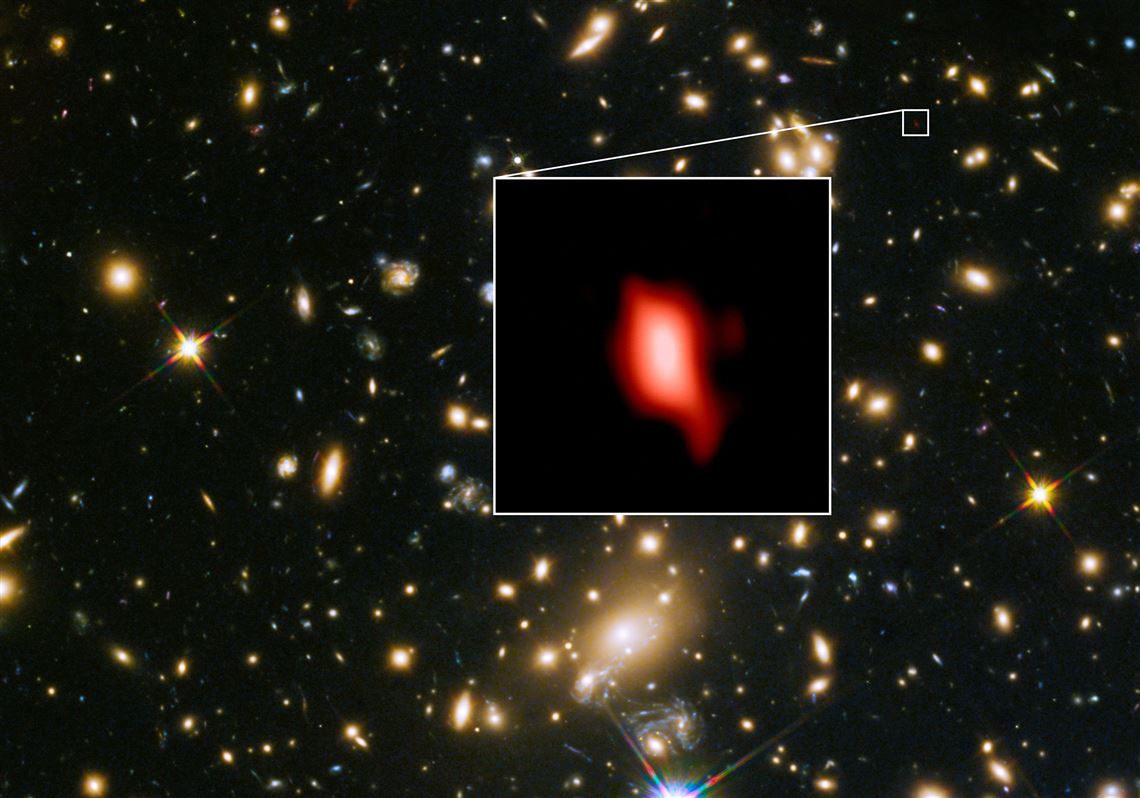In a distant galaxy more than 13 billion light-years from Earth, astronomers have discovered traces of the oldest known oxygen in the universe, as well as evidence that ancient stars “turned on” as early as 250 million years after the Big Bang.
These findings, published last week in Nature, suggest that star formation at the dawn of the cosmos may have been more common and robust than previously thought.
“It is not surprising that stars began to form at about that time, but what is surprising is that we found most of the stars in this galaxy were born so early,” said Richard Ellis, an astrophysicist at the University College of London who contributed to the study.
“Most models suggest star formation begins gradually, not in such a single burst of activity,” he added.
The ancient galaxy, known as MACS1149-JD1, was discovered in 2012, but scientists didn’t know how far away — and thus, approximately how old — it was until now.
To get an accurate measurement of its distance from Earth, an international team of astronomers used the ALMA telescope in the Chilean desert to look for the signature of ionized oxygen within the light emanating from the galaxy.
“ALMA is a very sensitive observatory, and oxygen is one of the most readily detected spectrum lines in hot gas,” Mr. Ellis said.
Because the universe is expanding, the spectrum line associated with the oxygen was stretched out as it traveled through space in a process known as redshift.
By measuring its wavelength once it reached Earth, scientists were able to get a remarkably accurate picture of how long this light has been beaming across the cosmos.
The oxygen line from MACS1149-JD1 originally was emitted at a wavelength of about 88 microns, but by the time it reached ALMA, it had stretched to about 893 microns, said Takuya Hashimoto, an astronomer at Osaka Sangyo University and the National Astronomical Observatory of Japan who led the study.
That indicates that the light from this galaxy was emitted 13.28 billion years ago, when the universe was about 550 million years old, he said.
But that’s just part of the story.
Immediately after the Big Bang, there was no oxygen in the universe. That’s because oxygen can be forged only in the nuclear furnace of stars. And it is released into the cosmos only when those stars die.
Therefore, the presence of oxygen in the MACS1149-JD1 galaxy suggests that by 500 million years after the Big Bang, this galaxy already had reached a certain level of chemical maturity. Stars had already died there.
To get a more accurate picture of how old the galaxy was when it was emitting light 13.28 billion years ago, the astronomy team studied its color with the help of the Hubble and Spitzer space telescopes.
“The redder the galaxy, the older the stellar population,” said study co-author Nicolas Laporte, a researcher at University College London. “And in our case, we have a very red galaxy, which is due to old stars.”
Indeed, these measurements allowed the scientists to determine that many of the stars in MACS1149-JD1 were already 300 million years old 13.28 billion years ago. This means they had to have formed about 250 million years after the Big Bang — when the universe was just 2 percent its present age.
As usual, these new discoveries have led researchers to ask more questions.
For example, are there many galaxies in the universe as old as this one, or is this an extra-old outlier?
Mr. Ellis said the team already has plans to observe two additional distant galaxies to determine their ages. Perhaps one, or both, of them will be of a similar vintage.
Mr. Hashimoto added that when the James Webb Space Telescope comes online around 2020, it is likely that many more distant galaxies will be discovered.
Also, if stars were turning on en masse 250 million years after the Big Bang, then how early in the universe’s history did the first stars light up the darkness of space?
“The mature stellar population in MACS1149-JD1 implies that stars were forming back to even earlier times, beyond what we can currently see with our telescopes,” Mr. Laporte said. “This has very exciting implications for finding ‘cosmic dawn’ when the first galaxies emerged.”
First Published: May 21, 2018, 6:00 a.m.
















